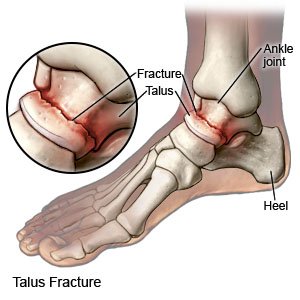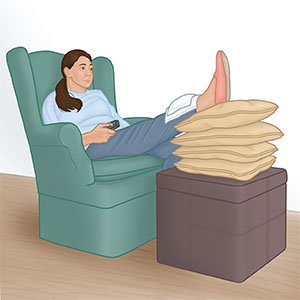Talar Fracture in Adults
Medically reviewed by Drugs.com. Last updated on Aug 4, 2025.
AMBULATORY CARE:
A talar fracture
is a break in the talus bone of your foot. The talus bone is a square, flat bone on top of the calcaneus (heel bone). It connects the heel with the lower leg bones to form the ankle.
 |
Common signs and symptoms:
- Pain, tenderness, or swelling
- Bruising or warm skin
- Trouble moving your ankle or foot
- Not being able to put weight on your ankle or foot
- Ankle bones that look out of place
Call your local emergency number (911 in the US) if:
- You suddenly feel lightheaded and short of breath.
- You have chest pain when you take a deep breath or cough.
- You cough up blood.
Seek care immediately if:
- You have severe pain.
- Your cast breaks or gets damaged.
- Your toes are numb, swollen, cold, or pale.
- Your leg feels warm, tender, and painful. It may look swollen and red.
Call your doctor if:
- You have a fever.
- You have new blood stains or a bad smell coming from under your cast.
- You have increased pain or swelling, even after treatment.
- You have questions or concerns about your condition or care.
Treatment
may include any of the following:
- Support devices such as casts and removable boots prevent ankle movement and help your talar fracture heal. A support device may be the only treatment you need. Crutches can help you move around until the bone heals.
- Medicines may be given to prevent or treat pain or a bacterial infection.
- Surgery may be needed for a severe fracture or the bones are broken into many pieces. Wires, pins, or metal plates may be used to hold the pieces together in the correct position.
Self-care:
- Rest your ankle as much as possible. Return to normal activities as directed.
- Apply ice to decrease swelling and pain, and to prevent tissue damage. Use an ice pack, or put crushed ice in a plastic bag. Cover it with a towel before you apply it. Apply ice for 15 to 20 minutes every hour or as directed.
- Elevate your ankle above the level of your heart as often as you can. This will help decrease swelling and pain. Prop your leg on pillows or blankets to keep your ankle elevated comfortably.

Support devices
such as casts and removable boots prevent ankle movement and help your talar fracture heal. A support device may be the only treatment you need. Crutches can help you move around until the bone heals.
Follow up with your doctor as directed:
Write down your questions so you remember to ask them during your visits.
© Copyright Merative 2025 Information is for End User's use only and may not be sold, redistributed or otherwise used for commercial purposes.
The above information is an educational aid only. It is not intended as medical advice for individual conditions or treatments. Talk to your doctor, nurse or pharmacist before following any medical regimen to see if it is safe and effective for you.
Further information
Always consult your healthcare provider to ensure the information displayed on this page applies to your personal circumstances.
